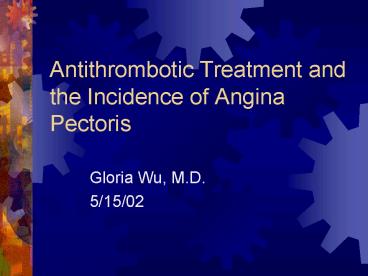Antithrombotic Treatment and the Incidence of Angina Pectoris - PowerPoint PPT Presentation
1 / 22
Title:
Antithrombotic Treatment and the Incidence of Angina Pectoris
Description:
Warfarin is known to have beneficial effect on IHD ... medical exam, reports by research nurses in between annual exams, patients ... – PowerPoint PPT presentation
Number of Views:113
Avg rating:3.0/5.0
Title: Antithrombotic Treatment and the Incidence of Angina Pectoris
1
Antithrombotic Treatment and the Incidence of
Angina Pectoris
- Gloria Wu, M.D.
- 5/15/02
2
Why study Warfarin as a treatment for Angina
Pectoris?
- Warfarin is known to have beneficial effect on
IHD - The PCABG trial found that effect of warfarin was
only seen on long term follow-up, suggesting that
it may act by reducing the formation of atheroma - delaying onset of angina may be associated with
reduced risk of future IHD events
3
Thrombosis Prevention Trial
- -1983-92, Great Britain
- -low-dose antithrombotic treatment in preventing
angina and major CHD - -Prevention of CHD- results published in 1998
4
Study Design
- 45-69 year-old men recruited from 108 general
practices in Britain. - 25 highest risk patients eligible to enter study
(BMI, total cholesterol, BP, plasma fibrinogen,
factor VII activity) - Excluded patients with angina, risk factors for
bleeding - Mean INR1.5 ASA dose 75mg
5
Prefactorial Phase(1983-89)
1427 Patients
706 Warfarin
721 Placebo
Factorial Phase (1989-92)
221 Withdrew
193 Refused Factorial
1013 Entered Factorial Stage
4072 entered Factorial Stage directly
1268 warfarin placebo
1277 warfarin aspirin
1268 placebo aspirin
1272 placebo placebo
751 withdrew
735 withdrew
735 withdrew
748 withdrew
6
Study Design cont
- Follow up 6.8 yrs for major outcomes (MI or
coronary death) and 5.0 yrs for angina - Diagnosis of angina definite Vs probable Vs
doubtful (table 1) - Annual medical exam, reports by research nurses
in between annual exams, patients withdrawing
from trial secondary to angina
7
Is this a good study?
- Randomization
- Double-blinded and placebo
- Similarities among groups
- Groups treated equally
- Intention to treat
8
Randomization and similarities among groups
- Random allocation through computer-generated
numbers - Similar characteristics among treatment groups
9
Characteristics at trial entry
10
Double-blind and placebo controlled
- Prolonged bleeding led some practice staff and
men in the trial to assume they were on active tx - Treatment code was broken in emergencies (such as
major bleed), medication incompatible with trial
tx.
11
Are the groups treated equally?
- Dosage changes made for those on placebo as on
active treatment - Equal testing among groups
12
Results- major CHD
- Prevention of major CHD warfarin and ASA each
reduced the incidence of CHD by 20(p0.02) - Warfarin reduces fatal episodes by 39(p0.003),
while ASA reduces nonfatal episodes by
32(p0.004) - Combined tx reduces fatal or nonfatal by 34
- major CHD defined as coronary death and fatal
and nonfatal MI - results published in Lancet, 1998
13
Results- incidence of all angina
- Total 128 definite cases, 76 probable cases, 15
doubtful cases - Warfarin reduces all angina(definite and
probable) by 11(p0.42), NNT200 - ASA increases all angina (definite and
probable)by 33(p0.05)
14
Results stable angina
- Warfarin reduces the incidence of stable angina
by 16(p0.26) - ASA increases the incidence of stable angina by
39(p0.05)
15
Discussion
- No significant reduction in angina but
significant reduction in major CHD. Why? - -was follow-up time sufficient? (gt85 of onset
of angina occurred gt12months) - -was diagnosis of angina made correctly?
- - is there a poor correlation between symptom
and severity of disease?
16
Discussion cont
- How about combining ASA and warfarin in
preventing angina?- 27 increase in all angina - Why did ASA increase the incidence of angina?
- Comparison with other studies- unclear if ASA has
any effect on the incidence of angina
17
Aspirin and Incident Angina
18
Are the results applicable to our patients?
- Are our patients different?
- Is the treatment feasible in our setting?
- What are our patients potential benefits and
harms from the therapy
19
Patient Population
- 45-69 y.o. men recruited from 108 practices in
Great Britain - Demographics not reported, but most likely
Caucasian - High risk patients
20
Is the treatment feasible?
- Requires monitoring of INR at least once every 6
months - Study was conducted in a controlled environment
and only 5 noncompliance - Maybe more feasible if home-monitoring becomes
available
21
Risk of bleeding
22
Conclusion
- 1. Is incidence of angina lowered by warfarin?
More evidence needed - 2. Low dose warfarin prevents CHD in high risk
patients- must weigh risks and benefits. - 3. ASA increases incidence of angina
significantly































